Financial Analysis Report: Target Corporation Performance
VerifiedAdded on 2021/04/17
|14
|4143
|23
Report
AI Summary
This report presents a comprehensive financial analysis of Target Corporation, examining its performance through vertical and horizontal analysis of the income statement and balance sheet. The analysis identifies significant trends, comparing Target's performance with industry standards, and evaluating changes in key financial metrics such as gross margin, administrative expenses, and net earnings. The report also delves into the company's liquidity, assessing working capital, current ratio, quick ratio, and inventory turnover. The findings indicate both strengths and weaknesses in Target's financial health, highlighting areas where the company excels and where improvements are needed to align with industry averages and enhance overall financial stability. The report concludes with an overview of the company's financial position and performance over the analyzed period.

Running head: ACCOUNTING FINANCIAL ANALYSIS REPORT
Accounting Financial Analysis Report
Name of the Student:
Name of the University:
Authors Note:
Accounting Financial Analysis Report
Name of the Student:
Name of the University:
Authors Note:
Paraphrase This Document
Need a fresh take? Get an instant paraphrase of this document with our AI Paraphraser
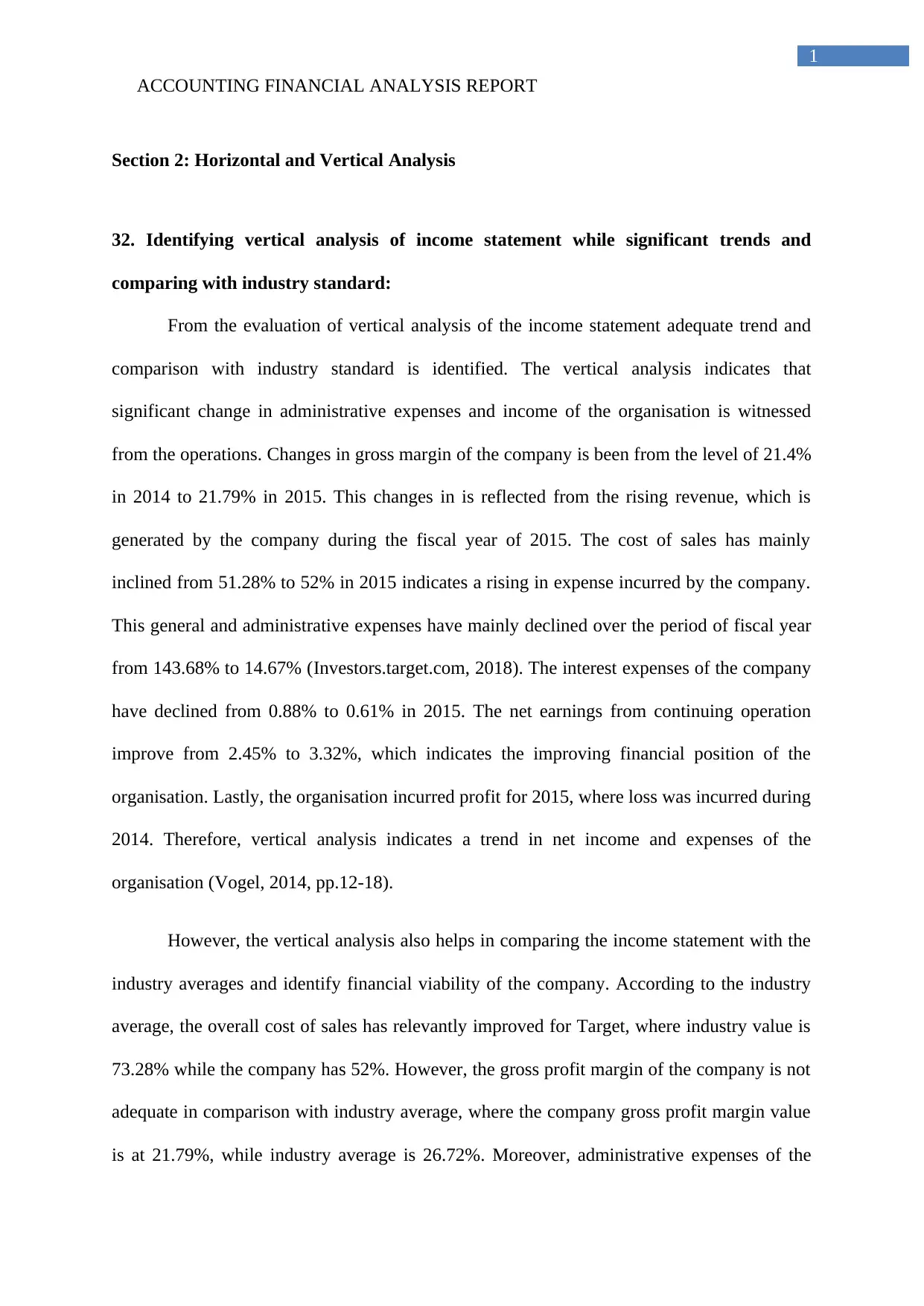
ACCOUNTING FINANCIAL ANALYSIS REPORT
1
Section 2: Horizontal and Vertical Analysis
32. Identifying vertical analysis of income statement while significant trends and
comparing with industry standard:
From the evaluation of vertical analysis of the income statement adequate trend and
comparison with industry standard is identified. The vertical analysis indicates that
significant change in administrative expenses and income of the organisation is witnessed
from the operations. Changes in gross margin of the company is been from the level of 21.4%
in 2014 to 21.79% in 2015. This changes in is reflected from the rising revenue, which is
generated by the company during the fiscal year of 2015. The cost of sales has mainly
inclined from 51.28% to 52% in 2015 indicates a rising in expense incurred by the company.
This general and administrative expenses have mainly declined over the period of fiscal year
from 143.68% to 14.67% (Investors.target.com, 2018). The interest expenses of the company
have declined from 0.88% to 0.61% in 2015. The net earnings from continuing operation
improve from 2.45% to 3.32%, which indicates the improving financial position of the
organisation. Lastly, the organisation incurred profit for 2015, where loss was incurred during
2014. Therefore, vertical analysis indicates a trend in net income and expenses of the
organisation (Vogel, 2014, pp.12-18).
However, the vertical analysis also helps in comparing the income statement with the
industry averages and identify financial viability of the company. According to the industry
average, the overall cost of sales has relevantly improved for Target, where industry value is
73.28% while the company has 52%. However, the gross profit margin of the company is not
adequate in comparison with industry average, where the company gross profit margin value
is at 21.79%, while industry average is 26.72%. Moreover, administrative expenses of the
1
Section 2: Horizontal and Vertical Analysis
32. Identifying vertical analysis of income statement while significant trends and
comparing with industry standard:
From the evaluation of vertical analysis of the income statement adequate trend and
comparison with industry standard is identified. The vertical analysis indicates that
significant change in administrative expenses and income of the organisation is witnessed
from the operations. Changes in gross margin of the company is been from the level of 21.4%
in 2014 to 21.79% in 2015. This changes in is reflected from the rising revenue, which is
generated by the company during the fiscal year of 2015. The cost of sales has mainly
inclined from 51.28% to 52% in 2015 indicates a rising in expense incurred by the company.
This general and administrative expenses have mainly declined over the period of fiscal year
from 143.68% to 14.67% (Investors.target.com, 2018). The interest expenses of the company
have declined from 0.88% to 0.61% in 2015. The net earnings from continuing operation
improve from 2.45% to 3.32%, which indicates the improving financial position of the
organisation. Lastly, the organisation incurred profit for 2015, where loss was incurred during
2014. Therefore, vertical analysis indicates a trend in net income and expenses of the
organisation (Vogel, 2014, pp.12-18).
However, the vertical analysis also helps in comparing the income statement with the
industry averages and identify financial viability of the company. According to the industry
average, the overall cost of sales has relevantly improved for Target, where industry value is
73.28% while the company has 52%. However, the gross profit margin of the company is not
adequate in comparison with industry average, where the company gross profit margin value
is at 21.79%, while industry average is 26.72%. Moreover, administrative expenses of the

ACCOUNTING FINANCIAL ANALYSIS REPORT
2
company are relatively lower than the industry average, which indicates the positive
attributes of the organisation. In addition, net interest expenses of the company have declined
adequately to meet the industry average. However, the overall net earnings from continuing
operations is relatively at 3.32%, which is lower than industry average of 3.41%
(Investors.target.com, 2018). This indicates the low financial performance of the organisation
in comparison to industry average. Lastly, the average net income is not adequate, which
does not respond to the financial improvements of the organisation.
34. Identifying vertical analysis of balance sheet while significant trends and comparing
with industry standard:
The vertical analysis could help in detecting significant tend of the company and
compare with industry standard. the asset section of the balance sheet mainly comprises of
current and non-current assets, which could be used in detecting the financial trend of the
company. The evaluation helps in detecting that current asset of the company has relatively
improved in 2015, as compared to 2014, while relevant decline in the composition of non-
current assets is detected. Increment in value of cash and cash equivalents and inventory can
be detected from vertical analysis, while decline in value of other current assets and assets
from discontinued operations is also detected. The current assets have increased from 33.09%
to 35.210%, while indicating an incremental asset of the organisation. Moreover, from the
valuation trend analysis of property and equipment has mainly declined from 63.03% to
62.63% in 2015. This relevantly indicates that the valuation of noncurrent assets has declined
over the period of fiscal year. The valuation of industry standard cash and cash equivalent is
relevantly high, as company’s value is at 10.05%, while industry average is 4.20%.
Additionally, investor level of the company has 21.36%, while industry average is at 19.56%.
Lastly, the total current asset of the organisation is relatively high in comparison with
2
company are relatively lower than the industry average, which indicates the positive
attributes of the organisation. In addition, net interest expenses of the company have declined
adequately to meet the industry average. However, the overall net earnings from continuing
operations is relatively at 3.32%, which is lower than industry average of 3.41%
(Investors.target.com, 2018). This indicates the low financial performance of the organisation
in comparison to industry average. Lastly, the average net income is not adequate, which
does not respond to the financial improvements of the organisation.
34. Identifying vertical analysis of balance sheet while significant trends and comparing
with industry standard:
The vertical analysis could help in detecting significant tend of the company and
compare with industry standard. the asset section of the balance sheet mainly comprises of
current and non-current assets, which could be used in detecting the financial trend of the
company. The evaluation helps in detecting that current asset of the company has relatively
improved in 2015, as compared to 2014, while relevant decline in the composition of non-
current assets is detected. Increment in value of cash and cash equivalents and inventory can
be detected from vertical analysis, while decline in value of other current assets and assets
from discontinued operations is also detected. The current assets have increased from 33.09%
to 35.210%, while indicating an incremental asset of the organisation. Moreover, from the
valuation trend analysis of property and equipment has mainly declined from 63.03% to
62.63% in 2015. This relevantly indicates that the valuation of noncurrent assets has declined
over the period of fiscal year. The valuation of industry standard cash and cash equivalent is
relevantly high, as company’s value is at 10.05%, while industry average is 4.20%.
Additionally, investor level of the company has 21.36%, while industry average is at 19.56%.
Lastly, the total current asset of the organisation is relatively high in comparison with
⊘ This is a preview!⊘
Do you want full access?
Subscribe today to unlock all pages.

Trusted by 1+ million students worldwide
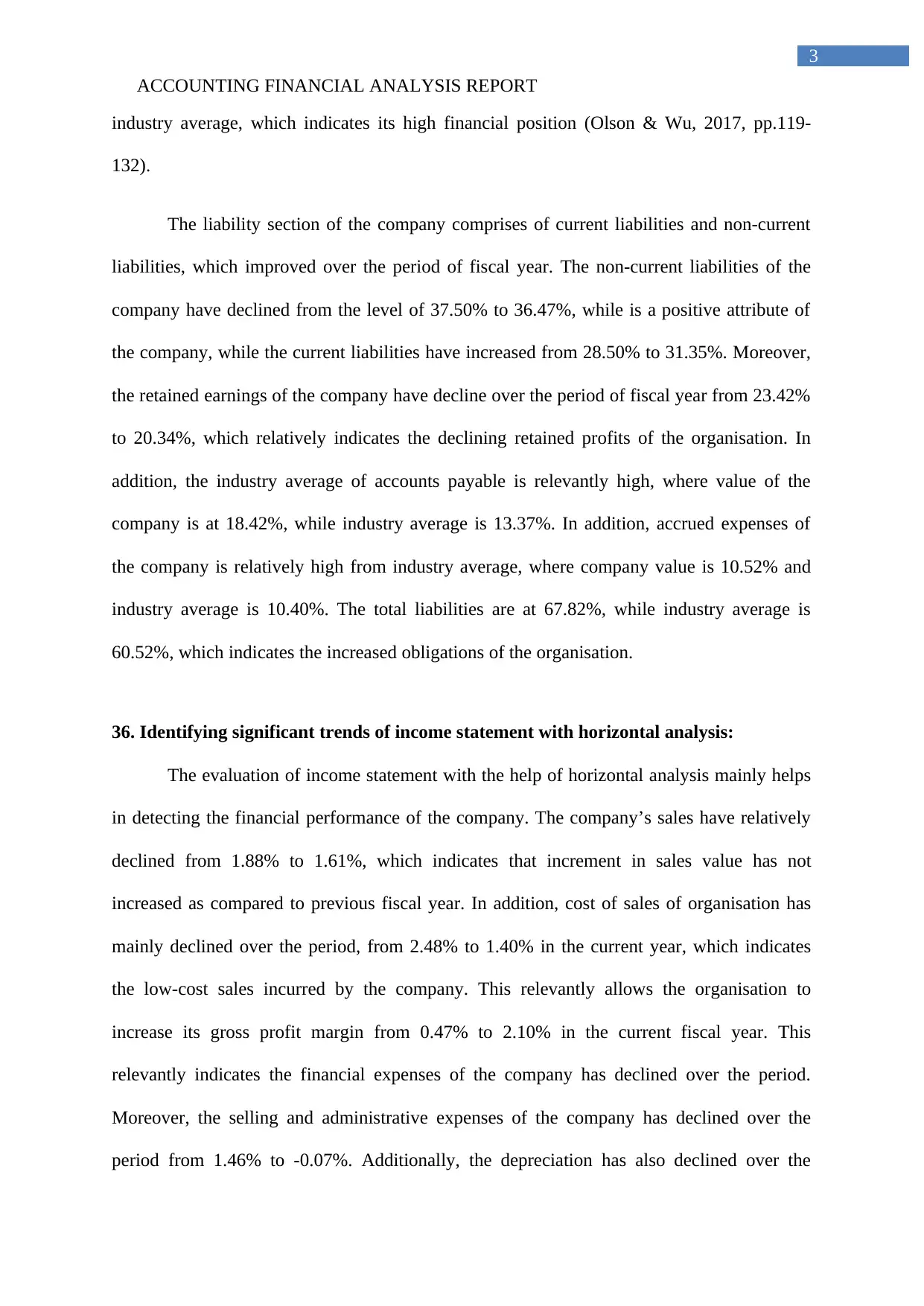
ACCOUNTING FINANCIAL ANALYSIS REPORT
3
industry average, which indicates its high financial position (Olson & Wu, 2017, pp.119-
132).
The liability section of the company comprises of current liabilities and non-current
liabilities, which improved over the period of fiscal year. The non-current liabilities of the
company have declined from the level of 37.50% to 36.47%, while is a positive attribute of
the company, while the current liabilities have increased from 28.50% to 31.35%. Moreover,
the retained earnings of the company have decline over the period of fiscal year from 23.42%
to 20.34%, which relatively indicates the declining retained profits of the organisation. In
addition, the industry average of accounts payable is relevantly high, where value of the
company is at 18.42%, while industry average is 13.37%. In addition, accrued expenses of
the company is relatively high from industry average, where company value is 10.52% and
industry average is 10.40%. The total liabilities are at 67.82%, while industry average is
60.52%, which indicates the increased obligations of the organisation.
36. Identifying significant trends of income statement with horizontal analysis:
The evaluation of income statement with the help of horizontal analysis mainly helps
in detecting the financial performance of the company. The company’s sales have relatively
declined from 1.88% to 1.61%, which indicates that increment in sales value has not
increased as compared to previous fiscal year. In addition, cost of sales of organisation has
mainly declined over the period, from 2.48% to 1.40% in the current year, which indicates
the low-cost sales incurred by the company. This relevantly allows the organisation to
increase its gross profit margin from 0.47% to 2.10% in the current fiscal year. This
relevantly indicates the financial expenses of the company has declined over the period.
Moreover, the selling and administrative expenses of the company has declined over the
period from 1.46% to -0.07%. Additionally, the depreciation has also declined over the
3
industry average, which indicates its high financial position (Olson & Wu, 2017, pp.119-
132).
The liability section of the company comprises of current liabilities and non-current
liabilities, which improved over the period of fiscal year. The non-current liabilities of the
company have declined from the level of 37.50% to 36.47%, while is a positive attribute of
the company, while the current liabilities have increased from 28.50% to 31.35%. Moreover,
the retained earnings of the company have decline over the period of fiscal year from 23.42%
to 20.34%, which relatively indicates the declining retained profits of the organisation. In
addition, the industry average of accounts payable is relevantly high, where value of the
company is at 18.42%, while industry average is 13.37%. In addition, accrued expenses of
the company is relatively high from industry average, where company value is 10.52% and
industry average is 10.40%. The total liabilities are at 67.82%, while industry average is
60.52%, which indicates the increased obligations of the organisation.
36. Identifying significant trends of income statement with horizontal analysis:
The evaluation of income statement with the help of horizontal analysis mainly helps
in detecting the financial performance of the company. The company’s sales have relatively
declined from 1.88% to 1.61%, which indicates that increment in sales value has not
increased as compared to previous fiscal year. In addition, cost of sales of organisation has
mainly declined over the period, from 2.48% to 1.40% in the current year, which indicates
the low-cost sales incurred by the company. This relevantly allows the organisation to
increase its gross profit margin from 0.47% to 2.10% in the current fiscal year. This
relevantly indicates the financial expenses of the company has declined over the period.
Moreover, the selling and administrative expenses of the company has declined over the
period from 1.46% to -0.07%. Additionally, the depreciation has also declined over the
Paraphrase This Document
Need a fresh take? Get an instant paraphrase of this document with our AI Paraphraser
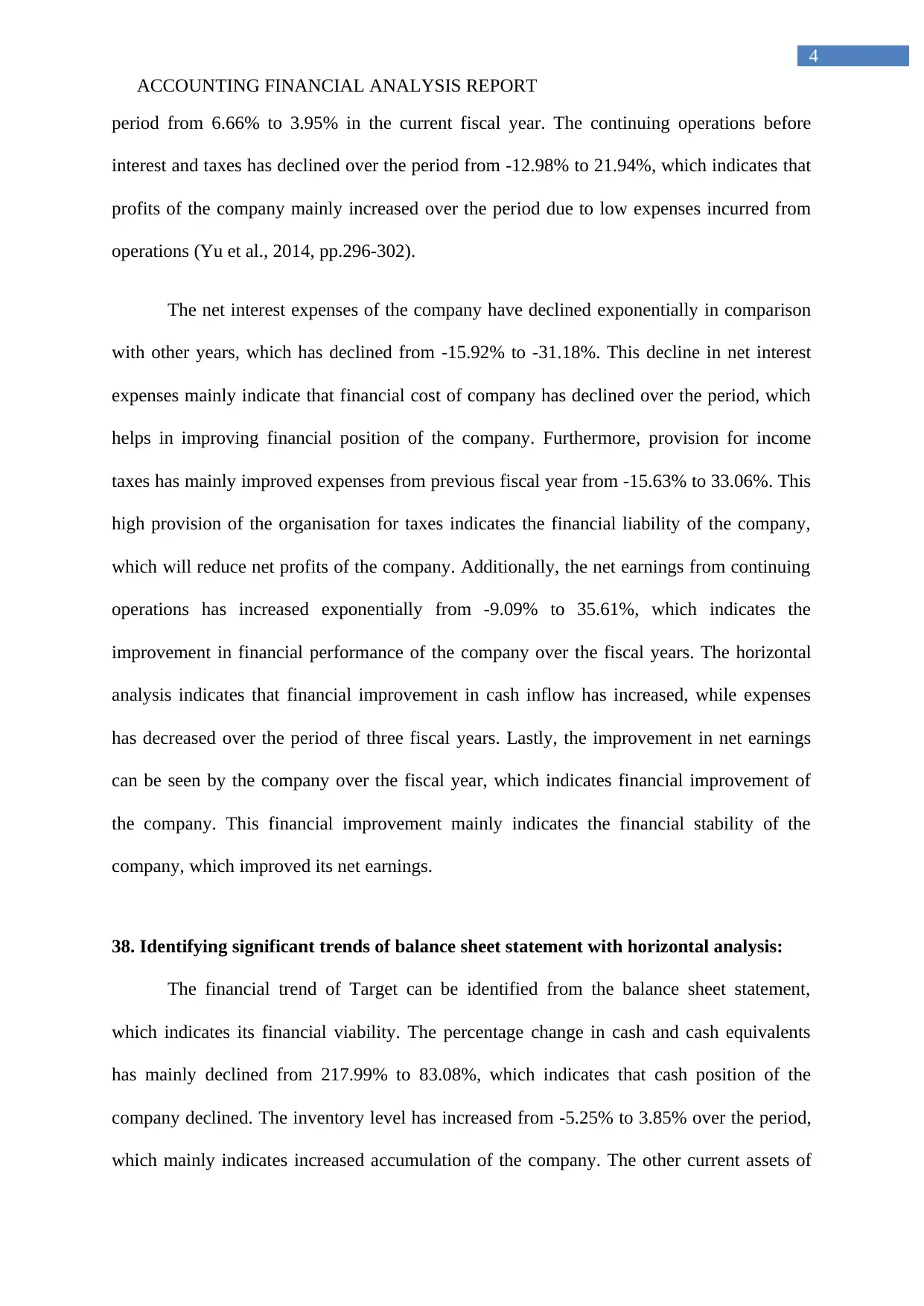
ACCOUNTING FINANCIAL ANALYSIS REPORT
4
period from 6.66% to 3.95% in the current fiscal year. The continuing operations before
interest and taxes has declined over the period from -12.98% to 21.94%, which indicates that
profits of the company mainly increased over the period due to low expenses incurred from
operations (Yu et al., 2014, pp.296-302).
The net interest expenses of the company have declined exponentially in comparison
with other years, which has declined from -15.92% to -31.18%. This decline in net interest
expenses mainly indicate that financial cost of company has declined over the period, which
helps in improving financial position of the company. Furthermore, provision for income
taxes has mainly improved expenses from previous fiscal year from -15.63% to 33.06%. This
high provision of the organisation for taxes indicates the financial liability of the company,
which will reduce net profits of the company. Additionally, the net earnings from continuing
operations has increased exponentially from -9.09% to 35.61%, which indicates the
improvement in financial performance of the company over the fiscal years. The horizontal
analysis indicates that financial improvement in cash inflow has increased, while expenses
has decreased over the period of three fiscal years. Lastly, the improvement in net earnings
can be seen by the company over the fiscal year, which indicates financial improvement of
the company. This financial improvement mainly indicates the financial stability of the
company, which improved its net earnings.
38. Identifying significant trends of balance sheet statement with horizontal analysis:
The financial trend of Target can be identified from the balance sheet statement,
which indicates its financial viability. The percentage change in cash and cash equivalents
has mainly declined from 217.99% to 83.08%, which indicates that cash position of the
company declined. The inventory level has increased from -5.25% to 3.85% over the period,
which mainly indicates increased accumulation of the company. The other current assets of
4
period from 6.66% to 3.95% in the current fiscal year. The continuing operations before
interest and taxes has declined over the period from -12.98% to 21.94%, which indicates that
profits of the company mainly increased over the period due to low expenses incurred from
operations (Yu et al., 2014, pp.296-302).
The net interest expenses of the company have declined exponentially in comparison
with other years, which has declined from -15.92% to -31.18%. This decline in net interest
expenses mainly indicate that financial cost of company has declined over the period, which
helps in improving financial position of the company. Furthermore, provision for income
taxes has mainly improved expenses from previous fiscal year from -15.63% to 33.06%. This
high provision of the organisation for taxes indicates the financial liability of the company,
which will reduce net profits of the company. Additionally, the net earnings from continuing
operations has increased exponentially from -9.09% to 35.61%, which indicates the
improvement in financial performance of the company over the fiscal years. The horizontal
analysis indicates that financial improvement in cash inflow has increased, while expenses
has decreased over the period of three fiscal years. Lastly, the improvement in net earnings
can be seen by the company over the fiscal year, which indicates financial improvement of
the company. This financial improvement mainly indicates the financial stability of the
company, which improved its net earnings.
38. Identifying significant trends of balance sheet statement with horizontal analysis:
The financial trend of Target can be identified from the balance sheet statement,
which indicates its financial viability. The percentage change in cash and cash equivalents
has mainly declined from 217.99% to 83.08%, which indicates that cash position of the
company declined. The inventory level has increased from -5.25% to 3.85% over the period,
which mainly indicates increased accumulation of the company. The other current assets of
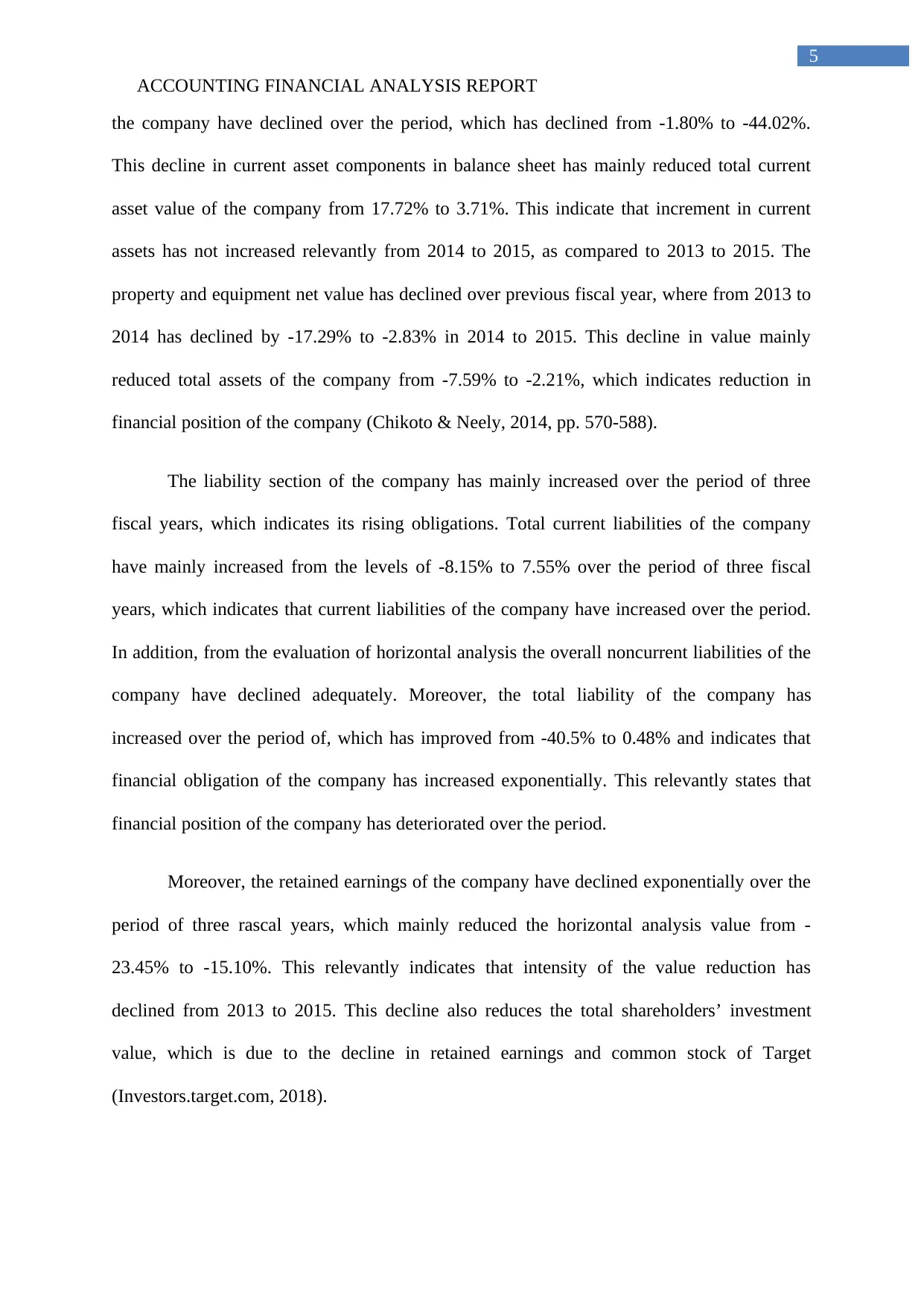
ACCOUNTING FINANCIAL ANALYSIS REPORT
5
the company have declined over the period, which has declined from -1.80% to -44.02%.
This decline in current asset components in balance sheet has mainly reduced total current
asset value of the company from 17.72% to 3.71%. This indicate that increment in current
assets has not increased relevantly from 2014 to 2015, as compared to 2013 to 2015. The
property and equipment net value has declined over previous fiscal year, where from 2013 to
2014 has declined by -17.29% to -2.83% in 2014 to 2015. This decline in value mainly
reduced total assets of the company from -7.59% to -2.21%, which indicates reduction in
financial position of the company (Chikoto & Neely, 2014, pp. 570-588).
The liability section of the company has mainly increased over the period of three
fiscal years, which indicates its rising obligations. Total current liabilities of the company
have mainly increased from the levels of -8.15% to 7.55% over the period of three fiscal
years, which indicates that current liabilities of the company have increased over the period.
In addition, from the evaluation of horizontal analysis the overall noncurrent liabilities of the
company have declined adequately. Moreover, the total liability of the company has
increased over the period of, which has improved from -40.5% to 0.48% and indicates that
financial obligation of the company has increased exponentially. This relevantly states that
financial position of the company has deteriorated over the period.
Moreover, the retained earnings of the company have declined exponentially over the
period of three rascal years, which mainly reduced the horizontal analysis value from -
23.45% to -15.10%. This relevantly indicates that intensity of the value reduction has
declined from 2013 to 2015. This decline also reduces the total shareholders’ investment
value, which is due to the decline in retained earnings and common stock of Target
(Investors.target.com, 2018).
5
the company have declined over the period, which has declined from -1.80% to -44.02%.
This decline in current asset components in balance sheet has mainly reduced total current
asset value of the company from 17.72% to 3.71%. This indicate that increment in current
assets has not increased relevantly from 2014 to 2015, as compared to 2013 to 2015. The
property and equipment net value has declined over previous fiscal year, where from 2013 to
2014 has declined by -17.29% to -2.83% in 2014 to 2015. This decline in value mainly
reduced total assets of the company from -7.59% to -2.21%, which indicates reduction in
financial position of the company (Chikoto & Neely, 2014, pp. 570-588).
The liability section of the company has mainly increased over the period of three
fiscal years, which indicates its rising obligations. Total current liabilities of the company
have mainly increased from the levels of -8.15% to 7.55% over the period of three fiscal
years, which indicates that current liabilities of the company have increased over the period.
In addition, from the evaluation of horizontal analysis the overall noncurrent liabilities of the
company have declined adequately. Moreover, the total liability of the company has
increased over the period of, which has improved from -40.5% to 0.48% and indicates that
financial obligation of the company has increased exponentially. This relevantly states that
financial position of the company has deteriorated over the period.
Moreover, the retained earnings of the company have declined exponentially over the
period of three rascal years, which mainly reduced the horizontal analysis value from -
23.45% to -15.10%. This relevantly indicates that intensity of the value reduction has
declined from 2013 to 2015. This decline also reduces the total shareholders’ investment
value, which is due to the decline in retained earnings and common stock of Target
(Investors.target.com, 2018).
⊘ This is a preview!⊘
Do you want full access?
Subscribe today to unlock all pages.

Trusted by 1+ million students worldwide
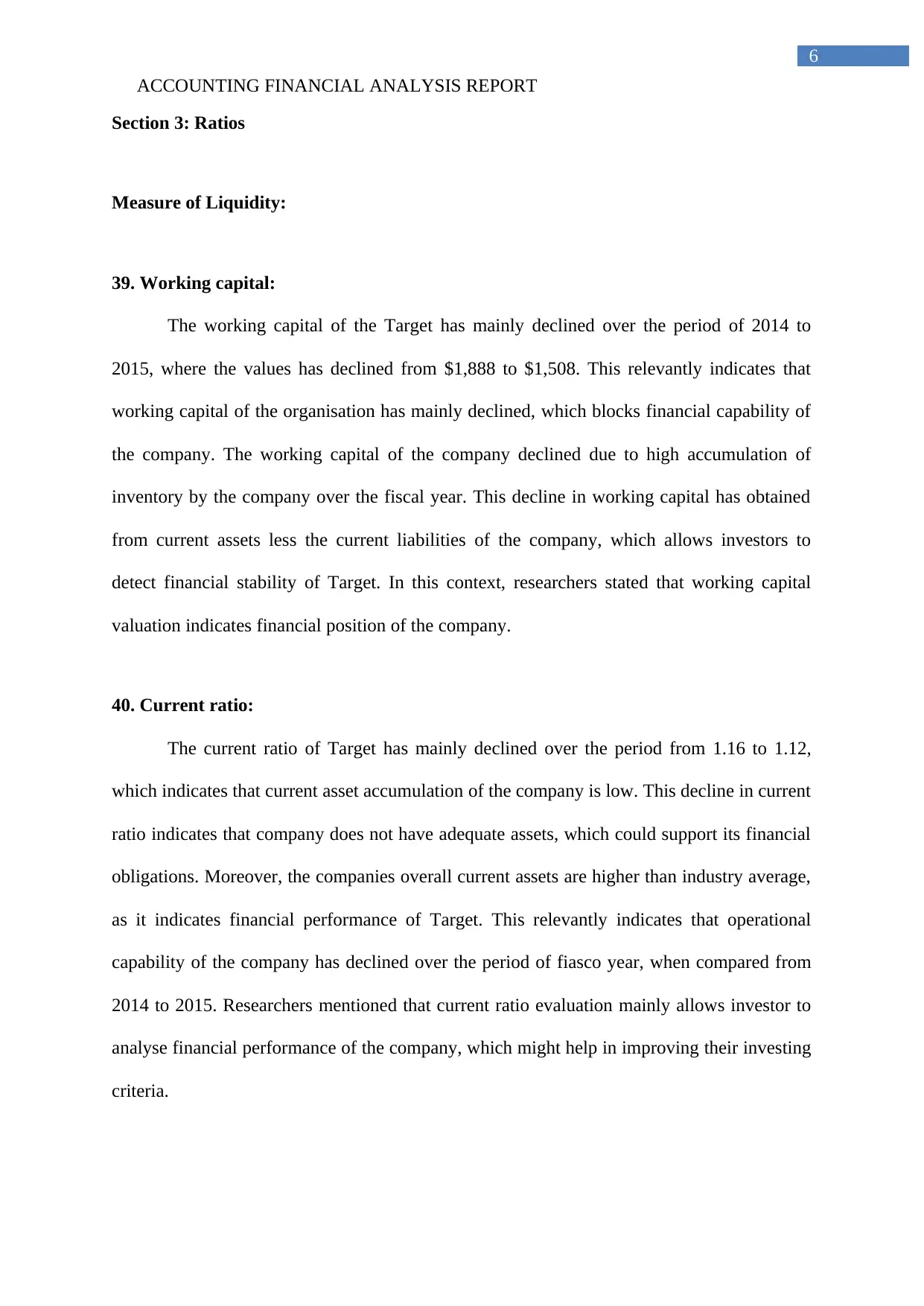
ACCOUNTING FINANCIAL ANALYSIS REPORT
6
Section 3: Ratios
Measure of Liquidity:
39. Working capital:
The working capital of the Target has mainly declined over the period of 2014 to
2015, where the values has declined from $1,888 to $1,508. This relevantly indicates that
working capital of the organisation has mainly declined, which blocks financial capability of
the company. The working capital of the company declined due to high accumulation of
inventory by the company over the fiscal year. This decline in working capital has obtained
from current assets less the current liabilities of the company, which allows investors to
detect financial stability of Target. In this context, researchers stated that working capital
valuation indicates financial position of the company.
40. Current ratio:
The current ratio of Target has mainly declined over the period from 1.16 to 1.12,
which indicates that current asset accumulation of the company is low. This decline in current
ratio indicates that company does not have adequate assets, which could support its financial
obligations. Moreover, the companies overall current assets are higher than industry average,
as it indicates financial performance of Target. This relevantly indicates that operational
capability of the company has declined over the period of fiasco year, when compared from
2014 to 2015. Researchers mentioned that current ratio evaluation mainly allows investor to
analyse financial performance of the company, which might help in improving their investing
criteria.
6
Section 3: Ratios
Measure of Liquidity:
39. Working capital:
The working capital of the Target has mainly declined over the period of 2014 to
2015, where the values has declined from $1,888 to $1,508. This relevantly indicates that
working capital of the organisation has mainly declined, which blocks financial capability of
the company. The working capital of the company declined due to high accumulation of
inventory by the company over the fiscal year. This decline in working capital has obtained
from current assets less the current liabilities of the company, which allows investors to
detect financial stability of Target. In this context, researchers stated that working capital
valuation indicates financial position of the company.
40. Current ratio:
The current ratio of Target has mainly declined over the period from 1.16 to 1.12,
which indicates that current asset accumulation of the company is low. This decline in current
ratio indicates that company does not have adequate assets, which could support its financial
obligations. Moreover, the companies overall current assets are higher than industry average,
as it indicates financial performance of Target. This relevantly indicates that operational
capability of the company has declined over the period of fiasco year, when compared from
2014 to 2015. Researchers mentioned that current ratio evaluation mainly allows investor to
analyse financial performance of the company, which might help in improving their investing
criteria.
Paraphrase This Document
Need a fresh take? Get an instant paraphrase of this document with our AI Paraphraser
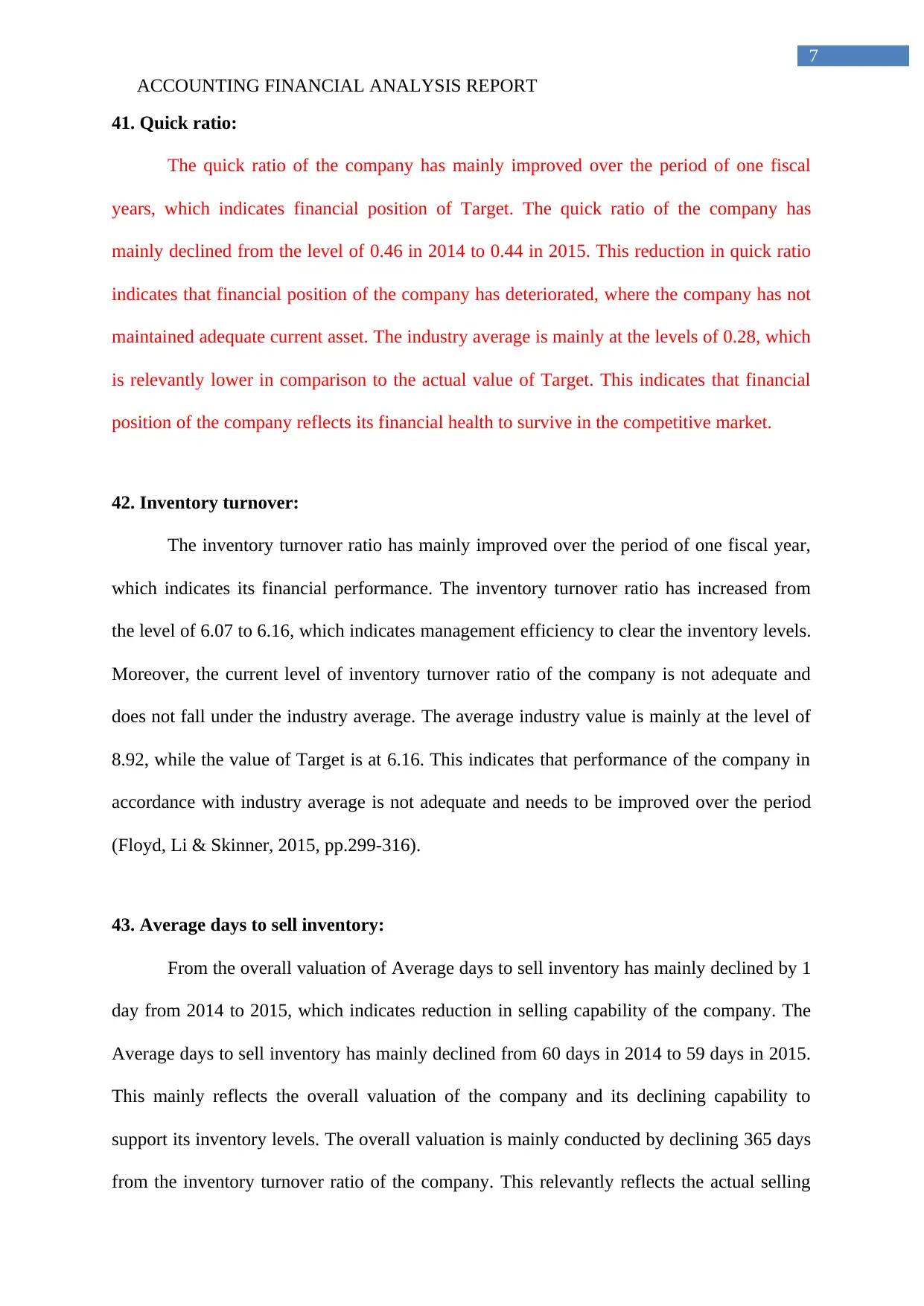
ACCOUNTING FINANCIAL ANALYSIS REPORT
7
41. Quick ratio:
The quick ratio of the company has mainly improved over the period of one fiscal
years, which indicates financial position of Target. The quick ratio of the company has
mainly declined from the level of 0.46 in 2014 to 0.44 in 2015. This reduction in quick ratio
indicates that financial position of the company has deteriorated, where the company has not
maintained adequate current asset. The industry average is mainly at the levels of 0.28, which
is relevantly lower in comparison to the actual value of Target. This indicates that financial
position of the company reflects its financial health to survive in the competitive market.
42. Inventory turnover:
The inventory turnover ratio has mainly improved over the period of one fiscal year,
which indicates its financial performance. The inventory turnover ratio has increased from
the level of 6.07 to 6.16, which indicates management efficiency to clear the inventory levels.
Moreover, the current level of inventory turnover ratio of the company is not adequate and
does not fall under the industry average. The average industry value is mainly at the level of
8.92, while the value of Target is at 6.16. This indicates that performance of the company in
accordance with industry average is not adequate and needs to be improved over the period
(Floyd, Li & Skinner, 2015, pp.299-316).
43. Average days to sell inventory:
From the overall valuation of Average days to sell inventory has mainly declined by 1
day from 2014 to 2015, which indicates reduction in selling capability of the company. The
Average days to sell inventory has mainly declined from 60 days in 2014 to 59 days in 2015.
This mainly reflects the overall valuation of the company and its declining capability to
support its inventory levels. The overall valuation is mainly conducted by declining 365 days
from the inventory turnover ratio of the company. This relevantly reflects the actual selling
7
41. Quick ratio:
The quick ratio of the company has mainly improved over the period of one fiscal
years, which indicates financial position of Target. The quick ratio of the company has
mainly declined from the level of 0.46 in 2014 to 0.44 in 2015. This reduction in quick ratio
indicates that financial position of the company has deteriorated, where the company has not
maintained adequate current asset. The industry average is mainly at the levels of 0.28, which
is relevantly lower in comparison to the actual value of Target. This indicates that financial
position of the company reflects its financial health to survive in the competitive market.
42. Inventory turnover:
The inventory turnover ratio has mainly improved over the period of one fiscal year,
which indicates its financial performance. The inventory turnover ratio has increased from
the level of 6.07 to 6.16, which indicates management efficiency to clear the inventory levels.
Moreover, the current level of inventory turnover ratio of the company is not adequate and
does not fall under the industry average. The average industry value is mainly at the level of
8.92, while the value of Target is at 6.16. This indicates that performance of the company in
accordance with industry average is not adequate and needs to be improved over the period
(Floyd, Li & Skinner, 2015, pp.299-316).
43. Average days to sell inventory:
From the overall valuation of Average days to sell inventory has mainly declined by 1
day from 2014 to 2015, which indicates reduction in selling capability of the company. The
Average days to sell inventory has mainly declined from 60 days in 2014 to 59 days in 2015.
This mainly reflects the overall valuation of the company and its declining capability to
support its inventory levels. The overall valuation is mainly conducted by declining 365 days
from the inventory turnover ratio of the company. This relevantly reflects the actual selling
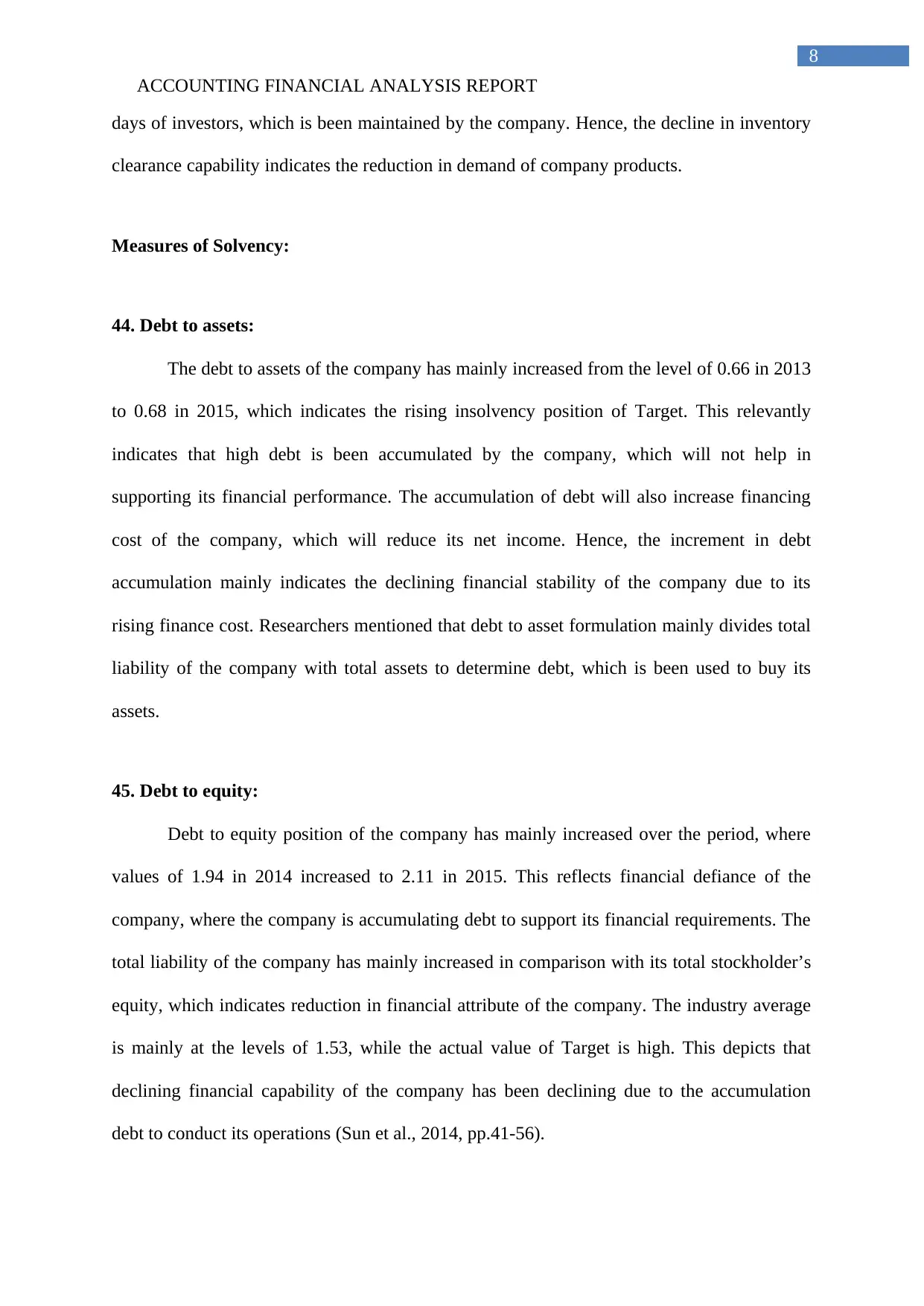
ACCOUNTING FINANCIAL ANALYSIS REPORT
8
days of investors, which is been maintained by the company. Hence, the decline in inventory
clearance capability indicates the reduction in demand of company products.
Measures of Solvency:
44. Debt to assets:
The debt to assets of the company has mainly increased from the level of 0.66 in 2013
to 0.68 in 2015, which indicates the rising insolvency position of Target. This relevantly
indicates that high debt is been accumulated by the company, which will not help in
supporting its financial performance. The accumulation of debt will also increase financing
cost of the company, which will reduce its net income. Hence, the increment in debt
accumulation mainly indicates the declining financial stability of the company due to its
rising finance cost. Researchers mentioned that debt to asset formulation mainly divides total
liability of the company with total assets to determine debt, which is been used to buy its
assets.
45. Debt to equity:
Debt to equity position of the company has mainly increased over the period, where
values of 1.94 in 2014 increased to 2.11 in 2015. This reflects financial defiance of the
company, where the company is accumulating debt to support its financial requirements. The
total liability of the company has mainly increased in comparison with its total stockholder’s
equity, which indicates reduction in financial attribute of the company. The industry average
is mainly at the levels of 1.53, while the actual value of Target is high. This depicts that
declining financial capability of the company has been declining due to the accumulation
debt to conduct its operations (Sun et al., 2014, pp.41-56).
8
days of investors, which is been maintained by the company. Hence, the decline in inventory
clearance capability indicates the reduction in demand of company products.
Measures of Solvency:
44. Debt to assets:
The debt to assets of the company has mainly increased from the level of 0.66 in 2013
to 0.68 in 2015, which indicates the rising insolvency position of Target. This relevantly
indicates that high debt is been accumulated by the company, which will not help in
supporting its financial performance. The accumulation of debt will also increase financing
cost of the company, which will reduce its net income. Hence, the increment in debt
accumulation mainly indicates the declining financial stability of the company due to its
rising finance cost. Researchers mentioned that debt to asset formulation mainly divides total
liability of the company with total assets to determine debt, which is been used to buy its
assets.
45. Debt to equity:
Debt to equity position of the company has mainly increased over the period, where
values of 1.94 in 2014 increased to 2.11 in 2015. This reflects financial defiance of the
company, where the company is accumulating debt to support its financial requirements. The
total liability of the company has mainly increased in comparison with its total stockholder’s
equity, which indicates reduction in financial attribute of the company. The industry average
is mainly at the levels of 1.53, while the actual value of Target is high. This depicts that
declining financial capability of the company has been declining due to the accumulation
debt to conduct its operations (Sun et al., 2014, pp.41-56).
⊘ This is a preview!⊘
Do you want full access?
Subscribe today to unlock all pages.

Trusted by 1+ million students worldwide
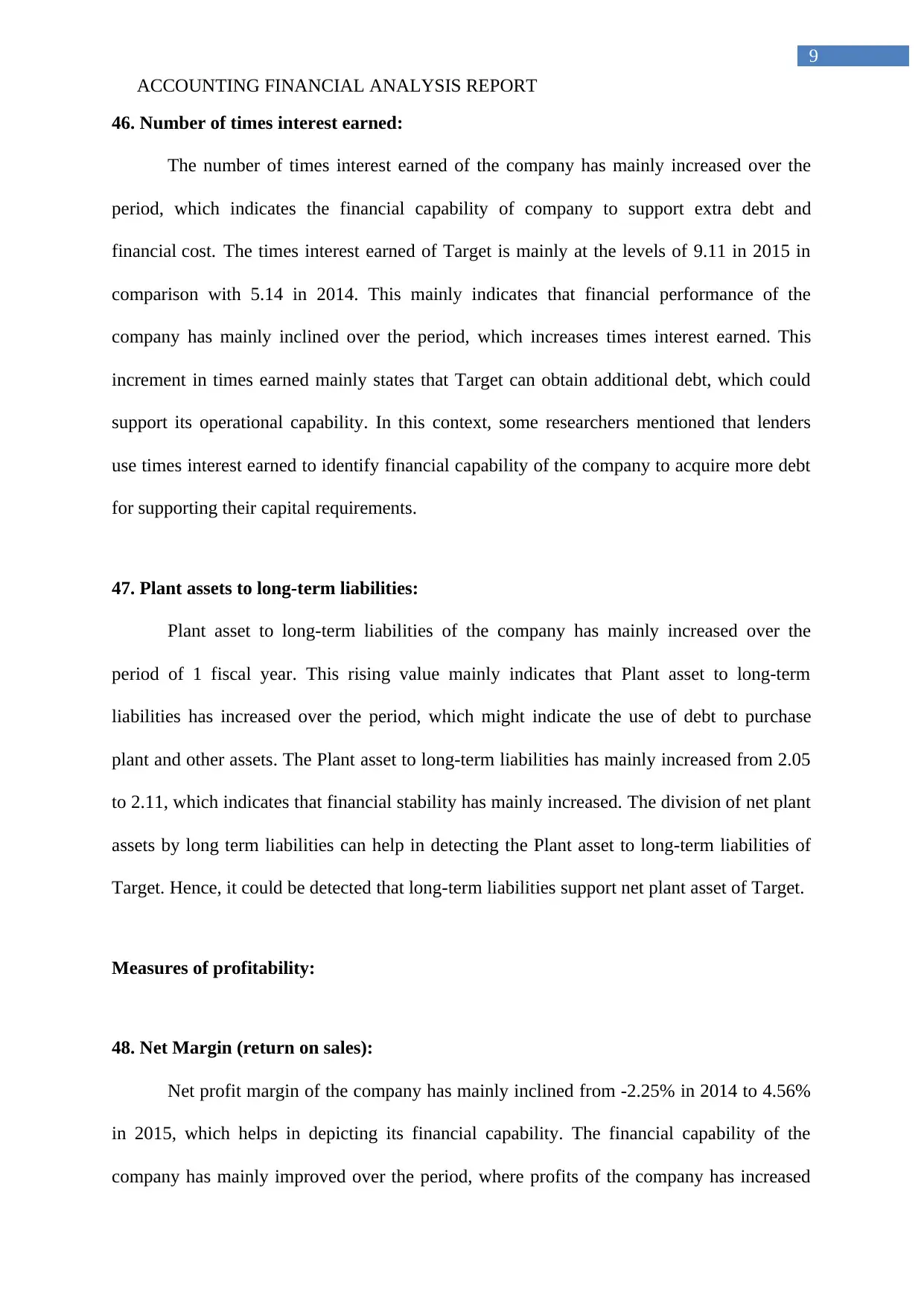
ACCOUNTING FINANCIAL ANALYSIS REPORT
9
46. Number of times interest earned:
The number of times interest earned of the company has mainly increased over the
period, which indicates the financial capability of company to support extra debt and
financial cost. The times interest earned of Target is mainly at the levels of 9.11 in 2015 in
comparison with 5.14 in 2014. This mainly indicates that financial performance of the
company has mainly inclined over the period, which increases times interest earned. This
increment in times earned mainly states that Target can obtain additional debt, which could
support its operational capability. In this context, some researchers mentioned that lenders
use times interest earned to identify financial capability of the company to acquire more debt
for supporting their capital requirements.
47. Plant assets to long-term liabilities:
Plant asset to long-term liabilities of the company has mainly increased over the
period of 1 fiscal year. This rising value mainly indicates that Plant asset to long-term
liabilities has increased over the period, which might indicate the use of debt to purchase
plant and other assets. The Plant asset to long-term liabilities has mainly increased from 2.05
to 2.11, which indicates that financial stability has mainly increased. The division of net plant
assets by long term liabilities can help in detecting the Plant asset to long-term liabilities of
Target. Hence, it could be detected that long-term liabilities support net plant asset of Target.
Measures of profitability:
48. Net Margin (return on sales):
Net profit margin of the company has mainly inclined from -2.25% in 2014 to 4.56%
in 2015, which helps in depicting its financial capability. The financial capability of the
company has mainly improved over the period, where profits of the company has increased
9
46. Number of times interest earned:
The number of times interest earned of the company has mainly increased over the
period, which indicates the financial capability of company to support extra debt and
financial cost. The times interest earned of Target is mainly at the levels of 9.11 in 2015 in
comparison with 5.14 in 2014. This mainly indicates that financial performance of the
company has mainly inclined over the period, which increases times interest earned. This
increment in times earned mainly states that Target can obtain additional debt, which could
support its operational capability. In this context, some researchers mentioned that lenders
use times interest earned to identify financial capability of the company to acquire more debt
for supporting their capital requirements.
47. Plant assets to long-term liabilities:
Plant asset to long-term liabilities of the company has mainly increased over the
period of 1 fiscal year. This rising value mainly indicates that Plant asset to long-term
liabilities has increased over the period, which might indicate the use of debt to purchase
plant and other assets. The Plant asset to long-term liabilities has mainly increased from 2.05
to 2.11, which indicates that financial stability has mainly increased. The division of net plant
assets by long term liabilities can help in detecting the Plant asset to long-term liabilities of
Target. Hence, it could be detected that long-term liabilities support net plant asset of Target.
Measures of profitability:
48. Net Margin (return on sales):
Net profit margin of the company has mainly inclined from -2.25% in 2014 to 4.56%
in 2015, which helps in depicting its financial capability. The financial capability of the
company has mainly improved over the period, where profits of the company has increased
Paraphrase This Document
Need a fresh take? Get an instant paraphrase of this document with our AI Paraphraser

ACCOUNTING FINANCIAL ANALYSIS REPORT
10
exponentially in 2015, where loss has incurred by the company in 2014. This increment in net
margin is due to the rising revenue and low expenses incurred by the company during the
fiscal year. The financial performance mainly indicates Target has increased its Net profit
during 2015, as compared to 2014, which has increased over the period (Olson & Wu, 2017,
pp.119-132).
49. Asset turnover:
The asset turnover ratio has mainly has mainly increased over the period, where
values has raised from 1.69 in 2014 to 1.81 in 2015. This increase in asset turnover ratio
indicates that financial performance of the company has improved over the period. This
increment in overall asset turnover ratio is due to the rising net sales, which is obtained by the
company during the fiscal year. This states that financial performance of Target has relatively
improved, which could be used by investors in making adequate investment decisions. Some
of the researchers stated that asset turnover ratio is mainly used by investors in declining
financial position of the company.
50. Return on investment:
The return on investment can mainly help in detecting financial performance and
profitability of the company. The return on investment has mainly increased from -3.82% to
8.26%, which indicate financial performance of Target in 2015. This increment in overall
return on investment is due to the high net profits incurred by the company. In addition, the
decline return on investment in 2014 is due to the loss incurred by the company during the
fiscal year. This was mainly possible when the overall expenses of the company declined in
2015 in comparison with 2014. Hence, the evaluation indicates that return generating
capability of the company by using the average total assets has improved over the period of
one fiscal year.
10
exponentially in 2015, where loss has incurred by the company in 2014. This increment in net
margin is due to the rising revenue and low expenses incurred by the company during the
fiscal year. The financial performance mainly indicates Target has increased its Net profit
during 2015, as compared to 2014, which has increased over the period (Olson & Wu, 2017,
pp.119-132).
49. Asset turnover:
The asset turnover ratio has mainly has mainly increased over the period, where
values has raised from 1.69 in 2014 to 1.81 in 2015. This increase in asset turnover ratio
indicates that financial performance of the company has improved over the period. This
increment in overall asset turnover ratio is due to the rising net sales, which is obtained by the
company during the fiscal year. This states that financial performance of Target has relatively
improved, which could be used by investors in making adequate investment decisions. Some
of the researchers stated that asset turnover ratio is mainly used by investors in declining
financial position of the company.
50. Return on investment:
The return on investment can mainly help in detecting financial performance and
profitability of the company. The return on investment has mainly increased from -3.82% to
8.26%, which indicate financial performance of Target in 2015. This increment in overall
return on investment is due to the high net profits incurred by the company. In addition, the
decline return on investment in 2014 is due to the loss incurred by the company during the
fiscal year. This was mainly possible when the overall expenses of the company declined in
2015 in comparison with 2014. Hence, the evaluation indicates that return generating
capability of the company by using the average total assets has improved over the period of
one fiscal year.
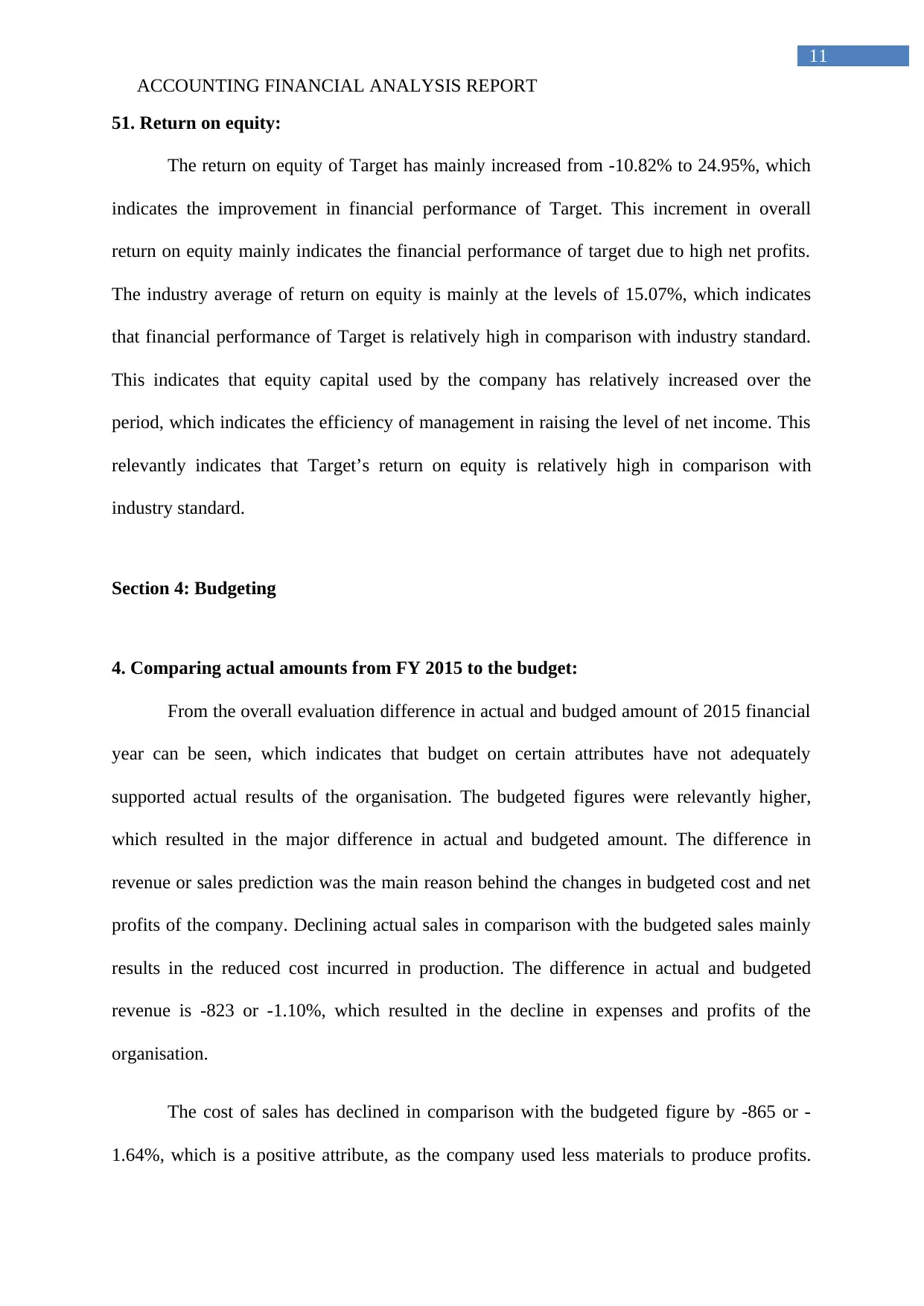
ACCOUNTING FINANCIAL ANALYSIS REPORT
11
51. Return on equity:
The return on equity of Target has mainly increased from -10.82% to 24.95%, which
indicates the improvement in financial performance of Target. This increment in overall
return on equity mainly indicates the financial performance of target due to high net profits.
The industry average of return on equity is mainly at the levels of 15.07%, which indicates
that financial performance of Target is relatively high in comparison with industry standard.
This indicates that equity capital used by the company has relatively increased over the
period, which indicates the efficiency of management in raising the level of net income. This
relevantly indicates that Target’s return on equity is relatively high in comparison with
industry standard.
Section 4: Budgeting
4. Comparing actual amounts from FY 2015 to the budget:
From the overall evaluation difference in actual and budged amount of 2015 financial
year can be seen, which indicates that budget on certain attributes have not adequately
supported actual results of the organisation. The budgeted figures were relevantly higher,
which resulted in the major difference in actual and budgeted amount. The difference in
revenue or sales prediction was the main reason behind the changes in budgeted cost and net
profits of the company. Declining actual sales in comparison with the budgeted sales mainly
results in the reduced cost incurred in production. The difference in actual and budgeted
revenue is -823 or -1.10%, which resulted in the decline in expenses and profits of the
organisation.
The cost of sales has declined in comparison with the budgeted figure by -865 or -
1.64%, which is a positive attribute, as the company used less materials to produce profits.
11
51. Return on equity:
The return on equity of Target has mainly increased from -10.82% to 24.95%, which
indicates the improvement in financial performance of Target. This increment in overall
return on equity mainly indicates the financial performance of target due to high net profits.
The industry average of return on equity is mainly at the levels of 15.07%, which indicates
that financial performance of Target is relatively high in comparison with industry standard.
This indicates that equity capital used by the company has relatively increased over the
period, which indicates the efficiency of management in raising the level of net income. This
relevantly indicates that Target’s return on equity is relatively high in comparison with
industry standard.
Section 4: Budgeting
4. Comparing actual amounts from FY 2015 to the budget:
From the overall evaluation difference in actual and budged amount of 2015 financial
year can be seen, which indicates that budget on certain attributes have not adequately
supported actual results of the organisation. The budgeted figures were relevantly higher,
which resulted in the major difference in actual and budgeted amount. The difference in
revenue or sales prediction was the main reason behind the changes in budgeted cost and net
profits of the company. Declining actual sales in comparison with the budgeted sales mainly
results in the reduced cost incurred in production. The difference in actual and budgeted
revenue is -823 or -1.10%, which resulted in the decline in expenses and profits of the
organisation.
The cost of sales has declined in comparison with the budgeted figure by -865 or -
1.64%, which is a positive attribute, as the company used less materials to produce profits.
⊘ This is a preview!⊘
Do you want full access?
Subscribe today to unlock all pages.

Trusted by 1+ million students worldwide
1 out of 14
Related Documents
Your All-in-One AI-Powered Toolkit for Academic Success.
+13062052269
info@desklib.com
Available 24*7 on WhatsApp / Email
![[object Object]](/_next/static/media/star-bottom.7253800d.svg)
Unlock your academic potential
Copyright © 2020–2025 A2Z Services. All Rights Reserved. Developed and managed by ZUCOL.





